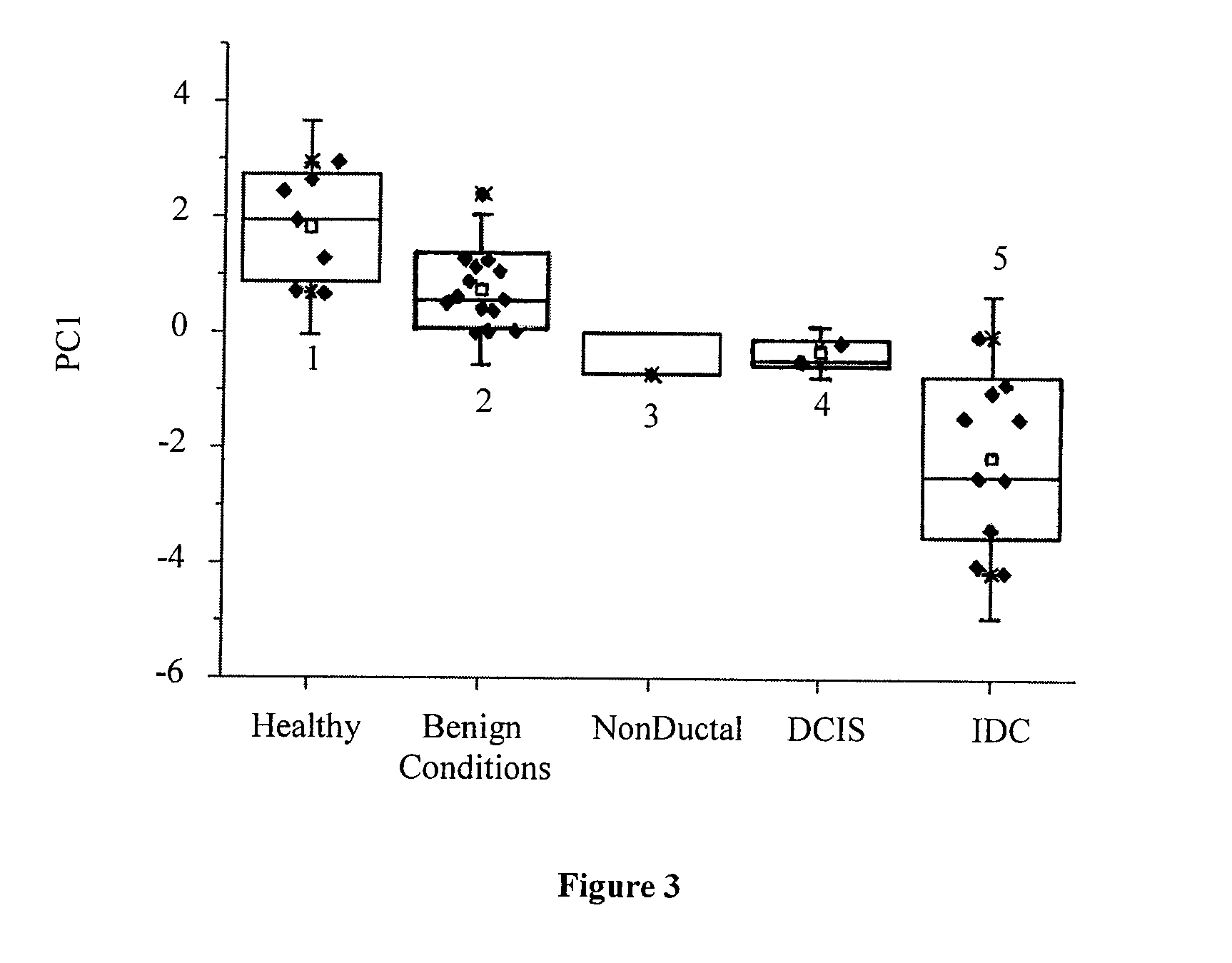Detection, Staging and Grading of Benign and Malignant Tumors
a tumor and benign technology, applied in the field of detection of benign and malignant tumors, can solve the problems of irreversible changes in the structure of the breast, the risk of breast cancer, and the induction and promotion of breast cancer, so as to improve the sensitivity and selectivity.
- Summary
- Abstract
- Description
- Claims
- Application Information
AI Technical Summary
Benefits of technology
Problems solved by technology
Method used
Image
Examples
example 1
Collection of Exhaled Breath
[0129]After deep exhaling, subjects inhaled to total lung capacity through a mouthpiece that contained a cartridge on the aspiratory port, in order to remove more than 99.99% of VOC ambient contaminants from inhaled air during inspiration. Subjects then exhaled against 10-15 cm of H2O pressure to ensure closure of the vellum to exclude nasal entrainment of gas. Exhaled gas was collected through a separate exhalation port of the mouthpiece in a non-reactive Mylar gas-sampling bag (purchased from Eco Medics), which was previously cleaned with N2 gas. Two Mylar bags were collected from each subject. The samples were collected and analyzed during a period of approximately 4 months.
example 2
Test Population
[0130]Breath samples were taken from 25 healthy women and 17 women with breast cancer at the ages of 26-73 after signed consent. All experiments were performed according to the guidelines of the Technion's committee for supervision of human experiments (Haifa, Israel). Four women (two of each population) were excluded from further testing due to technical problems. The healthy population was defined as women whose mammography testing showed no signs of tumor / s or alternatively women whose mammography testing showed benign tumor / s (confirmed by biopsies). The breast cancer (BC) population was defined as women with abnormal mammography results that were further confirmed to be malignant using biopsy and / or pathological examination after surgical removal of the tumor. None of the patients received chemotherapy and / or other cancer treatment prior to the breath testing. The clinical characteristics of the studied populations are listed in table 1.
TABLE 1Clinical characteri...
example 3
Synthesis and Capping of Gold and Platinum Nanoparticles
[0131]Gold nanoparticles having an average size of about 5 nm were capped with different organic molecules (Tert-dodecanethiol, 2-Ethylhexanethiol, 2-Mercaptobenzyl alcohol, 2-Mercaptobenzoazole, and Calixarene). Gold nanoparticles capped with thiols were synthesized using the standard two-phase method according to Brust et al. (J. Chem. Soc., Chem. Corn., 801, 1994, 2), with some modifications according to Hostetler et al. (Langmuir, 1998, 14, 24). Briefly, AuCl4− was first transferred from aqueous HAuCl4.xH2O solution (25 ml, 31.5 mM) to a toluene solution by the phase-transfer reagent TOAB (80 ml, 34.3 mM). After the organic phase was isolated, excess of the thiols was added to the solution. The mole ratio of thiol:HAuCl4.xH2O varied between 1:1 and 10:1 depending on the thiol used, in order to prepare monodispersed solution of gold nanoparticles having an average size of about 5 nm. After vigorous stirring of the solution f...
PUM
| Property | Measurement | Unit |
|---|---|---|
| size | aaaaa | aaaaa |
| distance | aaaaa | aaaaa |
| distance | aaaaa | aaaaa |
Abstract
Description
Claims
Application Information
 Login to View More
Login to View More - R&D
- Intellectual Property
- Life Sciences
- Materials
- Tech Scout
- Unparalleled Data Quality
- Higher Quality Content
- 60% Fewer Hallucinations
Browse by: Latest US Patents, China's latest patents, Technical Efficacy Thesaurus, Application Domain, Technology Topic, Popular Technical Reports.
© 2025 PatSnap. All rights reserved.Legal|Privacy policy|Modern Slavery Act Transparency Statement|Sitemap|About US| Contact US: help@patsnap.com



